Bugged by Bugs? Plant More Plants
Tired of bugs eating their way through your garden? Learn how you can combat the effects of pest bug damage through plant diversity.
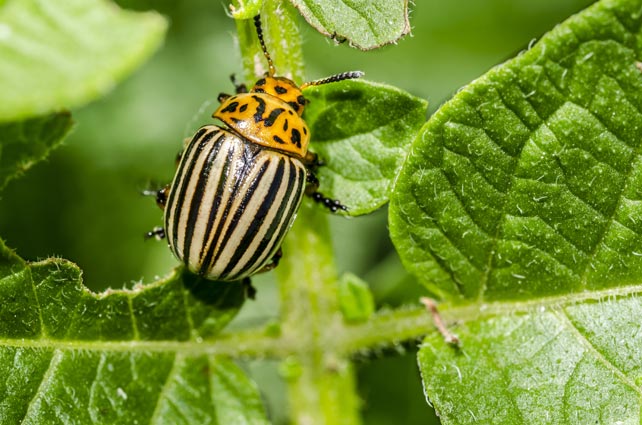
© Shutterstock
One of the many challenges that can foil your plants – especially in the vegetable garden – is bugs. Lots of bugs find your flowers, leaves, and vegetables tasty, so it’s often a race to determine who gets to enjoy or harvest the plantings first. However, the bug battle is a winnable one, with some planning and a willingness to learn.
Here’s a 10-step game plan for this season:
Do your homework and pick naturally bug-resistant varieties, especially on veggies. Labels, seed packets, and catalogs can help steer you.
Time your plantings to avoid bug reproduction cycles. A good strategy with vegetables is to pick ones with the shortest maturity times; less time in the ground means less time for bugs to attack. Stagger-plant small numbers of plants in several different locations instead of planting a whole block in one spot. Sometimes bugs find one or two plantings but not the others when they are spread out.
Bugs tend to pick on stressed plants first. It’s one of nature’s ways to weed out the least fit. Maximize growth and plant health by improving the soil with compost each year, testing the soil to maintain adequate nutrition, keeping the roots damp, and holding down weed competition.
Check plants regularly to catch small problems before they become big ones. For example, check roses regularly for aphids. They breed incredibly fast, and three or four today seem to become 100 in no time. Look underneath leaves for bug eggs that are often laid on the undersides, and squish or destroy them before they even hatch. Before automatically destroying, though it is wise to identify what you see. Remember, not everything that crawls or flies is a pest. The majority of bugs are harmless or beneficial, i.e. lady beetles, hoverflies, lacewings, and others eat "bad bugs", including aphids, thrips, mealybugs, and small caterpillars on vegetables and flowers. Also learn to separate the temporary, cosmetic, and acceptable damage from that which calls for immediate action; ignore the minor stuff. For vegetables, seek out the excellent resource book, "What’s Wrong with My Vegetable Garden?" by David Deardorff and Kathryn Wadsworth (Timber Press, 2011).
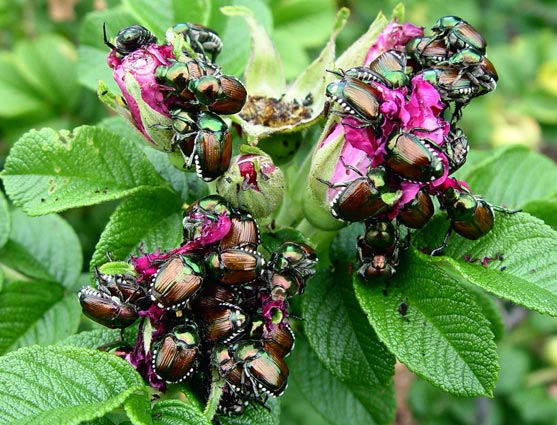
Bugs can quickly ruin a planting, but even mass swarmers like these Japanese beetles can be controlled if you’re prepared. © George Weigel
Mechanical barriers are cheap, easy, effective, and non-toxic. Block flying bugs with such devices such as light-weight floating row covers draped over broccoli to keep cabbageworms from laying eggs, cardboard "collars" wrapped around stems to guard against cutworms, and foil wrapped around the base of squash plants to discourage squash-vine-borer egg-laying.
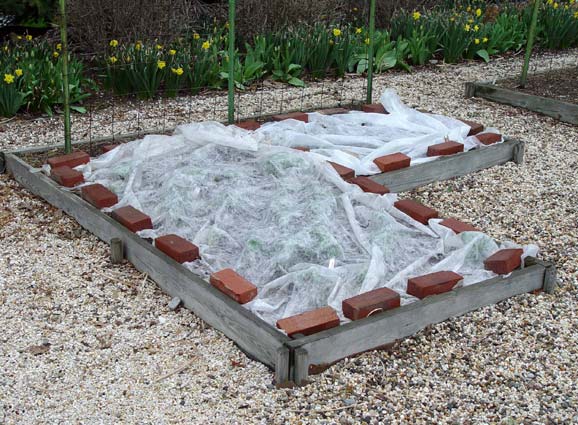
Floating row cover. © George Weigel
If you disguise attractive scents, you can "hide" the plants and keep pests from zeroing in on them. Shrewd gardeners "companion plant" by intermingling crops rather than planting in large, easy-to-find blocks or rows. Interplanting carrots with onions, for example, may fake carrot rust flies into thinking it’s a whole patch of stinky onions. Other gardeners concoct homemade garlic sprays or buy commercial spray repellents that have mint oils, cinnamon, or hot peppers as ingredients. Research has found that silver-colored plastic mulch (or foil) repels aphids.
The opposite of repelling bugs is attracting them with a contraption that captures them like glue traps. The simplest and cheapest is coating yellow cards with goo, such as petroleum jelly or a commercial product such as Tangle Trap. The color yellow attracts many bugs, and the goo grabs them like a fly trap. Beer traps are popular and simple to make to trap slugs on hostas. Commercial traps that use hormones or visual trickery to attract bugs are available too. The best known are Japanese beetle traps, but others that trap assorted other pests (thrips on flowers, codling moths on apples etc.) are available in garden centers. Some gardeners feel that Japanese beetle traps attract all the local beetles to their gardens resulting in more damage to hibiscus, roses, and other flowers.
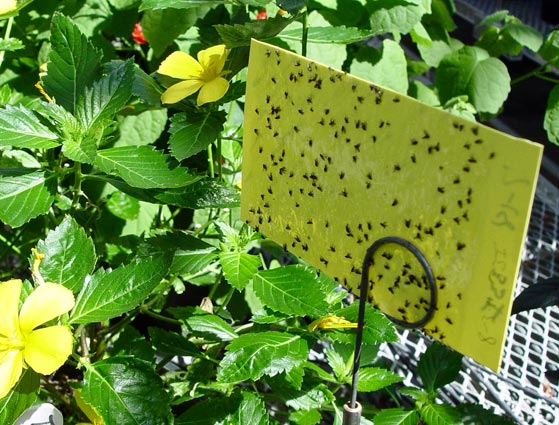
Yellow cards painted with bug-grabbing goo can trap pest bugs without resorting to sprays. © George Weigel
Hand-pick and squish or stomp larger bugs, such as potato beetles, hornworms, and slugs. Drop them in a can of hot, soapy water or rubbing alcohol. Soft-bodied bugs such as mites and aphids can be killed by a stiff spray of water. Colonies of small bugs can be sucked off plants with a hand-held vacuum; models specifically for bug use are made and sold in garden centers and catalogs.
Use nature to fight nature. The easiest route is to just stop spraying everything routinely to give beneficial insects a chance to build a population and eat pests. Encourage beneficials by planting favorite plants (dill, sweet alyssum, and cilantro are three of the best), or buy lady beetles, parasitic nematodes, and other beneficials for release into the garden. They’re available online, and in some garden catalogs, and garden centers. Bt, Spinosad, and Beauveria are among the naturally occurring bacteria and fungi that kill some bugs and that have been incorporated into sprays.
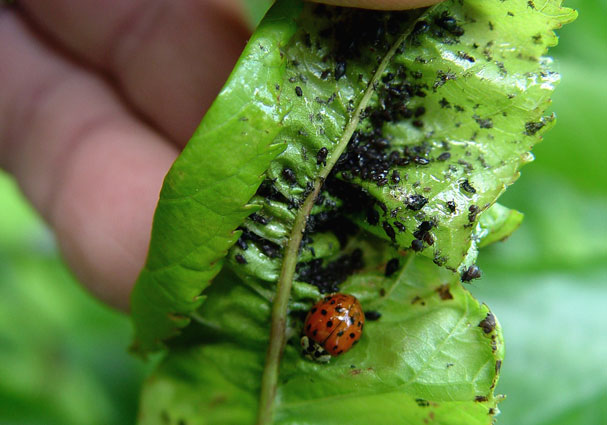
Not all that crawls is bad news in a garden. This lady beetle is in the process of cleaning up an aphid outbreak. © George Weigel
These are sprays that do the least collateral damage. For the best results timing is critical, as they are used directly on pests. Examples include insecticidal soap, horticultural oil, and neem oil, all of which are especially valuable as winter sprays on fruit trees and shrubs. Most of them work by eroding the bug’s shell or by smothering the bugs by coating them. For more on these and other "organic" bug controls, check out "Rodale's Vegetable Garden Problem Solver" book by Fern Marshall Bradley (Rodale Press, 2007).
The "big guns" are those that kill a wide variety of bugs fairly quickly and also have residual activity to kill ones that hatch later. Stick with products labeled for use on the plants being attacked and ones effective against the particular insect you have. Keep in mind that not all products kill all bugs. Read and follow all label precautions precisely, and don’t forget to use protective gear if so advised.